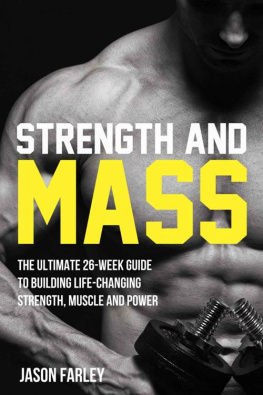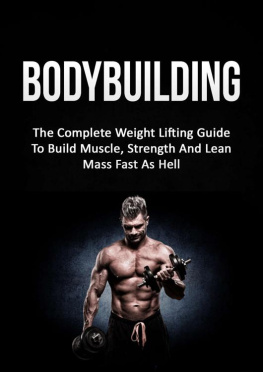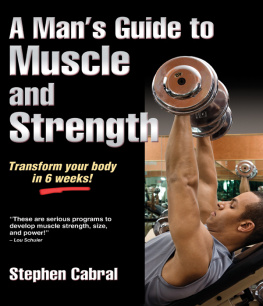Disclaimer:
You must get your physicians approval before beginning this exercise program. These recommendations are not medical guidelines and are for educational purposes only.
You must consult your physician prior to starting this program or if you have any medical condition or injury that contraindicates physical activity. This program is designed for healthy individuals 18 years and older only.
The information in this report is meant to supplement, not replace, proper exercise training. All forms of exercise pose some inherent risks. The editors and publishers advise readers to take full responsibility for their safety and know their limits. Before practicing the exercises in this book, be sure that your equipment is well-maintained, and do not take risks beyond your level of experience, aptitude, training and fitness. The exercises in this book are not intended as a substitute for any exercise routine or treatment or dietary regimen that may have been prescribed by your physician.
Dont lift heavy weights if you are alone, inexperienced, injured, or fatigued. Dont perform any exercise unless you have been shown the proper technique by a certified personal trainer or certified strength and conditioning specialist. Always ask for instruction and assistance when lifting. Dont perform any exercise without proper instruction. Always do a warm-up prior to strength training and interval training.
See your physician before starting any exercise or nutrition program. If you are taking any medications, you must talk to your physician before starting any exercise program, including this protocol. If you experience any lightheadedness, dizziness, or shortness of breath while exercising, stop the movement and consult a physician.
You must have a complete physical examination if you are sedentary, if you have high cholesterol, high blood pressure, or diabetes, if you are overweight, or if you are over 30 years old. Please discuss all nutritional changes with your physician or a registered dietician. If your physician recommends that you dont use this protocol, please follow your doctors orders.
More titles by Brad Pilon
at www.clkbooks.com:
Eat Stop Eat
How Much Protein
Good Belly, Bad Belly
Thin Air
Fat Cell Killer
Contents
Over the years lifting weights has become so frustrating that people dont even want to entertain the idea anymore.
People have moved on to gymnastics training, bodyweight training, yoga, kettlebells, anything OTHER than just lifting weights. All these forms of exercise have their benefits, but so does traditional weight training. The truth is weight training isnt complicated, weve just being doing it wrong for years. And by doing it wrong weve allowed frustration, lack of results, plateaus, and injuries to prevent us from reaping the benefits that could have been ours.
Ineffective weight training strategies have lead to misapplied effort and exertion. We try too hard at the wrong things. We focus on the amount of weight on the bar or we focus on how exhausted we are at the end of a workout.
We concentrate so much on the complexity of weight training, that weve missed the absolute fundamental basics.
Heres an example of what I mean.
Imagine you just finished doing the bench press with 205 pounds. On your last set you managed to complete 8 good repetitions. What do you do the next time you bench press?
Do you:
A)Try to do 205 pounds for 9 repetitions
B)Try to do 210 pounds for 7 repetitions
C)Try to do 195 pounds for 10 repetitions
While the traditional and most common approach would be A, Try to do 205 pounds for 9 repetitions, and another option might be B, Try to do 210 pounds for 7 repetitions the correct choice is C, Try and do 195 pounds for 10 repetitions.
So in this particular instance the correct choice is to lower the weight and do more repetitions. However, this doesnt mean EVERY SET should be a decrease in weight. Sometimes you should increase the weight and lower the amount of repetitions you attempt to complete.
As an example, if you can complete 10 good reps with 195 pounds, your next set should be with 225 pounds and you try to complete 5 good reps. After this, your next goal should be to complete 6 reps with 220 pounds, and then next you would use 215 pounds attempt to compete 7 good reps.If you are able to do this, then for your next set you should drop the weight down to 210 pounds and complete 8 repetitions
Only once you have completed all of these sets with good form should you ever attempt to do 205 pounds for 9 reps. However, once you are able to do all of these prescribed sets I can almost guarantee you will be able to compete 9 good reps with 205 pounds.
Heres why
The goal is not to increase the amount of reps you can do or increase the amount of weight you use, the goal is to increase your strength. The weight you use and the reps you use are only the tools you use to increase your strength.
There is a very well known, very reliable equation used to predict your one repetition maximum (1 rep max) in weightlifting. Your 1 rep max is the maximum amount of weight you can lift for 1 repetition using good form, which is an excellent measure of strength.
This equation calculates what I like to call your e1RM or your estimated 1 rep max.
The equation is as follows:
[(weight x repetitions) x 0.0333] + weight = Your e1RM
(dont worry, you dont need to ever use this equation Ive done the math for you)
This equation is an excellent predictor of strength. Using this equation you can see the massive mistake weve been making all these years the mistake that leads to not only plateaus but even devastating injuries.
Lets go back to our original example:
Being able to bench press 205 for 8 good reps is the equivalent of having a e1RM of 259.66nds. However, being able to bench press 205 for 9 good reps is the equivalent of having an e1RM of 266.49 pounds.
This is almost a 7 pound jump in maximal potential strength!
This is simply NOT something you are likely to accomplish in 1 week, let alone in the 2 minutes between your workout sets. Trying to make jumps of 5-7 pounds in strength with each set of any exercise is a recipe for disaster.
Now lets look at the other progression:
205 pounds for 8 repetitions = 259.66 pounds
195 pounds for 10 repetitions = 259.99 pounds
230 pounds for 4 repetitions = 260.64 pounds
225 pounds for 5 repetitions = 262.50 pounds
220 pounds for 6 repetitions = 264 pounds
215 pounds for 7 repetitions = 265.16 pounds
210 pounds for 8 repetitions = 265.99 pounds
205 pounds for 9 repetitions = 266.49 pounds
In this scenario there is only one progression that creates more than a 1.5 pound increase in strength, the rest are between 1.5 and 0.5 pounds. Yet, despite the slow, steady and methodical increase in e1RM, each set is an improvement on the previous set. The effort is high without reaching failure. There is an abundance of variety in both weight used and repetitions performed. There is slow and steady progress.
This is far more logical and far smoother than the traditional idea of trying to make large jumps in strength by increasing the reps by 1 with each workout
205 for 8 = 259.66 pounds
205 for 9 = 265.49 pounds
205 for 10 = 272.33 pounds
205 for 11 = 280.16 pounds
205 for 12 = 286.99 pounds
Thats an astonishing 27 plus pounds increase in strength in only 5 sets! Very desirable I admit, but also very unrealistic! Following a system like this for too long would end up at best with a long plateau in strength and size gains and at worst a very bad injury, especially as the weight gets heavier.










